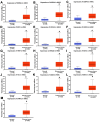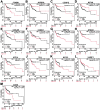Thymidine Kinase 1 Expression Correlates with Tumor Aggressiveness and Metastatic Potential in OSCC
- PMID: 40564887
- PMCID: PMC12192067
- DOI: 10.3390/diagnostics15121567
Thymidine Kinase 1 Expression Correlates with Tumor Aggressiveness and Metastatic Potential in OSCC
Abstract
Background/Objectives: Oral squamous cell carcinoma (OSCC) is the most prevalent malignancy of the oral cavity and is frequently diagnosed at an advanced stage, resulting in poor prognosis and limited treatment options. Identifying reliable biomarkers that can predict tumor progression and serve as therapeutic targets remains an urgent clinical need. Methods: To identify key molecular drivers in OSCC, we performed an integrative bioinformatics analysis of five OSCC-related microarray datasets from the Gene Expression Omnibus (GEO). Differentially expressed genes (DEGs) were identified and subjected to functional enrichment, protein-protein interaction (PPI) network construction, and hub gene ranking using Cytoscape. Candidate genes were further validated using TCGA, UALCAN, and the Human Protein Atlas. In vitro functional assays were performed to evaluate the effect of TK1 knockdown on cell migration. Results: A total of 138 common DEGs were identified across datasets. GO enrichment revealed that these genes were associated with cell proliferation, extracellular matrix organization, and metastasis-related processes. Thymidine kinase 1 (TK1) was identified as a key hub gene and found to be consistently overexpressed in OSCC tissues. Kaplan-Meier analysis showed that high TK1 expression correlated with poor overall survival in head and neck cancer. TK1 knockdown in OSCC cell lines significantly impaired cell migration and wound-healing ability. Conclusions: Our findings suggest that TK1 plays an active role in promoting OSCC progression and may serve as a prognostic biomarker and potential therapeutic target for metastatic OSCC.
Keywords: biomarker; differentially expressed genes (DEGs); metastasis; oral squamous cell carcinoma (OSCC); thymidine kinase 1 (TK1).
Conflict of interest statement
The authors declare no conflicts of interest.
Figures







Similar articles
-
Systemic pharmacological treatments for chronic plaque psoriasis: a network meta-analysis.Cochrane Database Syst Rev. 2021 Apr 19;4(4):CD011535. doi: 10.1002/14651858.CD011535.pub4. Cochrane Database Syst Rev. 2021. Update in: Cochrane Database Syst Rev. 2022 May 23;5:CD011535. doi: 10.1002/14651858.CD011535.pub5. PMID: 33871055 Free PMC article. Updated.
-
Integrated analysis of uterine leiomyosarcoma and leiomyoma utilizing TCGA and GEO data: a WGCNA and machine learning approach.Transl Cancer Res. 2025 May 30;14(5):2999-3016. doi: 10.21037/tcr-2024-2465. Epub 2025 May 13. Transl Cancer Res. 2025. PMID: 40530152 Free PMC article.
-
Systemic pharmacological treatments for chronic plaque psoriasis: a network meta-analysis.Cochrane Database Syst Rev. 2017 Dec 22;12(12):CD011535. doi: 10.1002/14651858.CD011535.pub2. Cochrane Database Syst Rev. 2017. Update in: Cochrane Database Syst Rev. 2020 Jan 9;1:CD011535. doi: 10.1002/14651858.CD011535.pub3. PMID: 29271481 Free PMC article. Updated.
-
Drugs for preventing postoperative nausea and vomiting in adults after general anaesthesia: a network meta-analysis.Cochrane Database Syst Rev. 2020 Oct 19;10(10):CD012859. doi: 10.1002/14651858.CD012859.pub2. Cochrane Database Syst Rev. 2020. PMID: 33075160 Free PMC article.
-
MCM4 as Potential Metastatic Biomarker in Lung Adenocarcinoma.Diagnostics (Basel). 2025 Jun 18;15(12):1555. doi: 10.3390/diagnostics15121555. Diagnostics (Basel). 2025. PMID: 40564876 Free PMC article.
References
-
- Chen F., Tang L., Xia T., He E., Hu G., Li Y., Zhang M., Zhou J., Eriksson S., Skog S. Serum thymidine kinase 1 levels predict cancer-free survival following neoadjuvant, surgical and adjuvant treatment of patients with locally advanced breast cancer. Mol. Clin. Oncol. 2013;1:894–902. doi: 10.3892/mco.2013.149. - DOI - PMC - PubMed
Grants and funding
LinkOut - more resources
Full Text Sources

